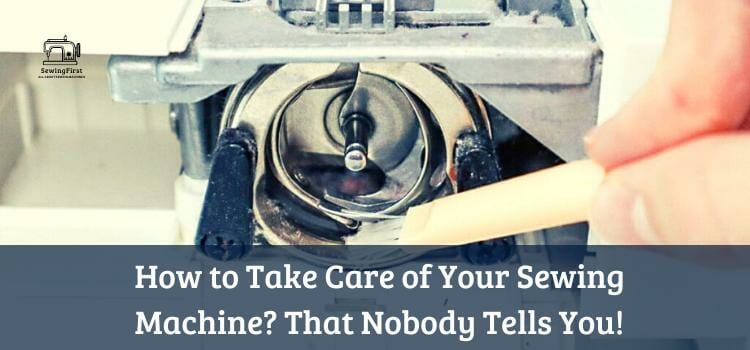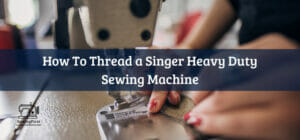Taking care of your sewing machine can seem like a daunting task, but it doesn’t have to be. Proper maintenance and upkeep will not only keep your machine running smoothly and efficiently, but it will also extend the life of your treasured tool.
If you want to ensure that your sewing projects come out looking their best and serve as an expression of creativity for years to come, then taking care of your sewing machine should become part of your regular routine.
This article will provide helpful tips on how to take care of your sewing machine in order to get the most out of its performance while preserving its longevity. From oiling the parts correctly to cleaning off lint buildup and more, we’ll cover all angles so that you can fulfill the purposeful mission of serving others with professional-looking results!
Every sewist needs a reliable, well-maintained machine at their side in order to create beautiful garments and home décor items with ease. So let’s get started learning about how to take care of our beloved machines!
Related Topic: How To Store A Sewing Machine (Safe Solutions)
Table of Contents
ToggleKeep Your Sewing Machine Covered
Making sure your sewing machine is properly cared for can often mean the difference between a successful project and one that falls short of expectations.
It’s essential to follow the instructions in your sewing machine manual, while also taking extra steps to ensure maximum efficiency when it comes time to sew. One way you can do this is by keeping your machine covered with a dust cover when not used.
This will help prevent lint build-up from gathering on the internal parts of the machine, prolonging its life and ensuring smooth operation each time you use it.
Additionally, having pieces of scrap fabric nearby during use can catch any loose fibers and stop them from getting into crevices or jamming up moving parts. Taking these simple precautions then will add years to your sewing machine’s lifespan and reduce problems that could arise over time due to lack of maintenance.
Change Needles Regularly
We’re all familiar with the feeling of excitement when we buy a new sewing machine. That shiny needle, gliding through the fabric and stitching out intricate designs—it’s like our own little piece of magic!
But if you want it to stay magical, it is important to take proper care of your sewing machine needle. Using proper needles for your particular type of sewing machine can make all the difference in the world.
If you use dull or broken needles, they could cause damage to both your fabric and machine as well as weaken seams and thread breakage. It also helps to replace needles regularly so that they don’t become too dull or bent over time and cause lint buildup inside the bobbin case which can lead to even more problems down the line.
Sharpening up those needles will keep them working at their best for longer periods of time; giving you smoother stitches without having to worry about any extra maintenance caused by lint buildup.
Get Lint Out With Compressed Air
Just like a car, regular maintenance keeps it in good working order and can prevent problems down the road. With this in mind, using compressed air to remove lint should be part of your ongoing routine:
Keeping your sewing machine free from lint buildup helps ensure that all its parts are working correctly. To get rid of any unwanted debris, you can use these tools:
- a lint brush
- cosmetic brush
- or a lint-free cloth
followed by wiping the surface with paper towels or a dry cloth. This simple but effective method will help keep your machine clean and functioning optimally.
Finally, don’t forget about annual servicing – taking care of small issues before they become larger ones pays off not only financially but also makes sure that you have fewer disruptions when you’re creating something special!
How to Take Care of Your Sewing Machine: Annual Servicing
In order to ensure the longevity of your beloved sewing machine, you need to take proper care of it. An annual servicing should be factored into your regular maintenance routine to ensure it’s running like a well-oiled machine!
A professional can help you spot any potential issues and get them fixed before they become costly problems. It’s also important to oil the moving parts of your sewing machines periodically, as this will keep all components working properly.
All you need is just a drop or two of good quality machine oil in each area where metal moves against metal – such as around the needle bar and feed dog. This may seem daunting at first, but if done correctly it won’t take long and will save you time and money down the line.
Oiling The Machine
Caring for a sewing machine is like taking care of a beloved pet; with just the right amount of attention, it will be happy and serve you faithfully. Oiling your sewing machine is one important step in proper maintenance.
A couple of drops of the correct type of sewing machine oil should be applied to various moving parts, depending on what kind of sewing machine you have. This lubrication helps ensure that the thread runs through properly and does not cause any jams or malfunctions. Not enough oil can lead to wear and tear on the machinery, making it less effective over time – an enemy to all machines!
To get started, find out which type of oil is best suited for your specific model. Then use a clean cloth or cotton swab to apply only a few drops at each point where indicated by the manual or instructions from an experienced professional.
Avoid pouring too much as this could damage components within the engine. With consistent upkeep such as this, your trusty companion will be ready when you need it most!
Get Your Machine Repaired By An Experienced Professional
For flawless fabric stitching, finding a professional fixer is fundamental. From Feed Dogs to Hook Race and Bobbin Race, it’s essential to ensure your machine functions optimally. When mending malfunctions or replacing parts, an experienced expert can assist in keeping your contraption contented.
Rather than risk ruining the needle plate with a DIY disaster, don’t hesitate to hire help. Consulting the manufacturer’s Machine Manual and locating a specialist are two of the top tactics for taking proper care of your sewing station. Doing this will guarantee you access to quality maintenance and repair services when necessary.
No matter what kind of challenges arise while caring for your equipment, remember there’s always someone who can aid in addressing them successfully. So take the time now to research reputable service providers near you today!
Clean One Part Of The Machine At A Time
When it comes to taking care of your sewing machine, cleaning it regularly is essential. This means more than just wiping the surface – you should also clean one part of the machine at a time. Here are some tips for doing that:
- Start by removing any threads and lint on the presser foot and surrounding area using a small brush or vacuum cleaner attachment.
- Thoroughly clean your sewing equipment like the needle plate, bobbin case, shuttle race, feed dog, etc with gentle detergent and warm water. Be sure to rinse them well afterward.
- When reassembling parts after cleaning, make sure everything is properly in place before powering up the machine again.
- Finally, use a surge protector when plugging in your machine – this will help protect against power surges while keeping it safe from electrical damage.
Regular maintenance of your sewing machine helps ensure optimal performance over its lifetime– so take time out of each day to give it some love!
Wipe Down The Machine After Each Use
Maintaining your sewing machine is an essential part of keeping it in top working condition. One way to do this is by wiping down the machine after each use. This helps remove any dust, dirt, or thread residue that may have accumulated over time and will help ensure it continues performing at its best.
When wiping down your sewing machine, make sure not to expose it to direct sunlight as this can damage certain components like the foot control and tension discs. Also, be careful to only use cold water when cleaning any plastic parts of the machine so you don’t risk melting them in warm temperatures.
Finally, always use high-quality thread on your sewing machine for optimal performance – cheap materials won’t stand up as well under heavy usage.
By taking these simple steps every time you work with your sewing machine, you’ll keep it running smoothly for years to come!
Read The Manual
Reading the manual is a great way to take care of your sewing machine. Not only will you learn how to use and maintain it correctly, but also ensure that all its parts are working properly and in sync with each other. It’s important to know exactly what type of bobbin thread and looped threads work best for your specific machine model, as well as any additional sewing tools you may need.
By taking some time to understand the entire machine inside and out, you can easily spot any broken threads or loose connections before they become an issue. This helps avoid costly repairs down the line and keeps your projects running smoothly.
Plus, if something does go wrong when using your machine, referring back to the manual can help troubleshoot quickly so you can get back on track without wasting valuable time.
Knowing how to properly use and maintain your sewing machine is essential – not only for preserving its lifespan but also for getting better results from every project you undertake.
Use The Right Sewing Machine For Your Project
When taking care of your sewing machine, it’s important to make sure you’re using the right one for your project. If you don’t have a specific model in mind that may be best suited for what you need to do, then research different types and brands of machines until you find the perfect fit. Not all machines are created equal, so take some time to look at the features each has available.
When deciding on a sewing machine, consider things like its stitch type selection, speed settings, and other accessories if applicable. There are also many functions that can help make your projects easier – from automatic threaders to needle-down positions.
Think about how much space is needed for storage too; sometimes these machines can require quite a bit! Making sure you have enough room before buying is essential. Once you’ve selected the ideal machine, caring for it properly will ensure it lasts as long as possible.
Don’t Use Damaged Equipment
Having the right sewing machine for your project is important, but it’s just as important to make sure that the equipment you’re using isn’t damaged. After all, if something goes wrong with a malfunctioning piece of machinery, it could lead to costly repairs or worse—injury.
So don’t take any chances and check each component of your sewing machine before beginning work on any project. Visually inspect everything from the power cord and foot pedal to the bobbin winding mechanism and thread tension regulator.
If anything looks worn or broken, replace it immediately. You can usually find replacement parts at local fabric stores or online retailers.
Making sure every part of your sewing machine is in good condition will help ensure that your projects turn out well and keep you safe while working. Taking these small steps now can save you time, money, and stress down the road when you start putting together more complex pieces.
Use The Proper Accessories And Attachments
No matter how good your sewing machine is, it won’t last forever if you don’t use the proper accessories and attachments. This means buying the right type of needles for different fabrics as well as bobbins that fit into your specific make and model. Not only this but also be sure to check any attached cords or hoses for signs of wear and tear before using them.
It’s essential to regularly inspect all the parts of your machine so you can identify when something needs to be replaced. Doing this will protect both your material investment in a new piece of equipment,
But more importantly, it’ll help keep everyone safe from potential issues like an electric shock or flying chips due to improper operation. With these precautions taken care of, now let’s look at ways to store and organize small accessories.
Storing And Organizing Small Accessories
Organizing and storing your sewing machine accessories is like an art form – you have to be creative, efficient, and organized all at once. It can be a challenge for even the most experienced seamstresses, but it’s worth the effort in order to keep your tools safe and ready when you need them. Here are three tips to help make this process easier:
- First, invest in bags or containers specifically designed to store small parts such as needles, bobbins, and threaders. This will help you quickly find what you need without rummaging through multiple drawers or boxes.
- Second, use labels so that everything stays tidy and easily identifiable; clear tape with handwritten tags works well here.
- Finally, if space allows it, buy larger storage solutions such as wall organizers or cabinets which are helpful for keeping the room neat while still having access to all of your supplies.
By taking these steps, not only will you save yourself time and frustration when searching for items during a project but also extend the life of your materials by protecting them from dust and other debris. With proper organization comes better maintenance! Let’s look now at some tips on how to keep your sewing tools and equipment last longer.
Tips To Keep Your Sewing Tools And Equipment Longer
Taking care of your sewing tools and equipment is like nurturing a garden—it requires regular tending to reap the most benefits. With just a few simple steps, you can keep them in top condition for years to come.
- First off, it’s important to store all items safely with labels on them so that they don’t get lost or misplaced.
- If possible, try to group similar pieces together; this not only saves time when searching for something specific but also makes it easier to find items quickly during a project.
- Always make sure your machine is covered when not in use as dust and dirt particles may damage its parts over time.
- Be sure to clean up any debris from fabric cutting or other tasks promptly because leaving them untouched accelerates wear and tear.
Keeping your supplies organized goes hand-in-hand with taking proper care of them, creating an environment conducive both to their longevity and creativity!
Importance Of Keeping Sewing Tools And Equipment In Good Condition
It’s almost like a life-saving rescue mission: keeping your sewing tools and equipment in good condition is absolutely essential to getting the job done – and this isn’t an exaggeration!
If you’re serious about making sure your projects look perfect, then it pays to take great care of all the materials that help make them happen. It might seem like a lot of effort, but it will be worth it in the long run.
The importance of maintaining these items properly can’t be overstated; regular cleanings, lubrications, and general checkups are necessary to ensure they stay working optimally.
Plus, taking proper precautions with storage and transportation can also go a long way towards preserving their longevity. Even if something appears minor at first glance, any wear and tear should be addressed right away as it could lead to more costly repairs down the line.
So don’t let yourself get overwhelmed – focus on prevention rather than cure by giving your machines some TLC so they’ll always be there when you need them most.
After all, why waste time fixing what could have been avoided? Taking good care of everything from stitching needles and measuring devices to scissors and thread spools is key for successful sewing projects every single time!
Conclusion
It’s no secret that sewing machines are an essential tool in any craftsperson’s arsenal. Keeping your machine well-maintained can help ensure it continues to perform optimally for years to come. With the proper care and maintenance, you can keep your beloved machine humming along for many a project.
So if you want to keep your sewing machine running smoothly, make sure to cover it when not in use, replace needles regularly, oil it from time to time, and take advantage of annual servicing—after all, it is always better safe than sorry!
FAQs
What are four tips for routine care of a sewing machine?
1. Regularly clean and oil the machine: Regularly cleaning and oiling your sewing machine helps to keep it running smoothly and efficiently.
2. Change the needle regularly: Regularly changing the needle helps to keep stitches even and consistent.
3. Keep it covered: To protect the machine from dust and other debris, keep it covered when not in use.
4. Check the tension: It is important to check the tension on the machine regularly to make sure the stitches look even and consistent.
How should a sewing machine be cared for between uses?
1. Clean the bobbin area and around the feed dogs with a soft brush or cloth.
2. Oil the machine as recommended by the manufacturer.
3. Check the bobbin case and thread tension.
4. Replace or clean the needle if necessary.
5. Cover the machine with a clean cloth when not in use.
6. Store the machine in a cool, dry place away from direct sunlight.
What are two ways of taking care of a sewing or knitting machine?
1. Regularly clean and oil the machine. Make sure to read the user manual and use recommended oils and cleaning products.
2. Regularly inspect and replace worn or damaged parts. Keep spare needles, bobbins, and other parts on hand so that you can replace them quickly.
How do you clean and care for a sewing machine?
1. Unplug the sewing machine and remove the needle and presser foot.
2. Clean the bed of the machine with a lightly dampened cloth.
3. Carefully remove any lint or debris from the bobbin area, and throat plate, and feed dogs.
4. Lubricate the machine as directed by the manufacturer.
5. Reassemble the needle and presser foot.
6. Plug in the machine and test it on a scrap of fabric.
7. Clean the exterior of the machine with a dry cloth.
8. Store the machine in a safe place, away from moisture and dust.
How often should you clean sewing machine?
It is recommended that you clean your sewing machine at least once per month, depending on how often you use it. If the machine is used regularly, it should be cleaned more often.
What are some three basic maintenance procedures in sewing?
1. Cleaning: Regularly clean your sewing machine and iron to keep them in good working order.
2. Lubrication: Ensure that all moving parts of your machine are properly lubricated to maintain optimal performance.
3. Adjustments: Make sure to adjust the tension and stitch length, as well as check the timing of your machine, to ensure that your stitches are even and consistent.
How do you maintain a Singer sewing machine?
1. Dust and clean the machine regularly.
2. Oil the machine regularly, following the manufacturer’s instructions.
3. Change the needle often.
4. Clean the bobbin and bobbin case at least once a month.
5. Keep the machine free from lint and thread build-up.
6. Inspect the machine for any loose screws or worn or damaged parts.
7. Make sure the machine is properly tensioned and the thread is correctly threaded.
8. Replace any worn or broken parts as soon as possible.
9. Have the machine serviced by a qualified technician at least once a year





